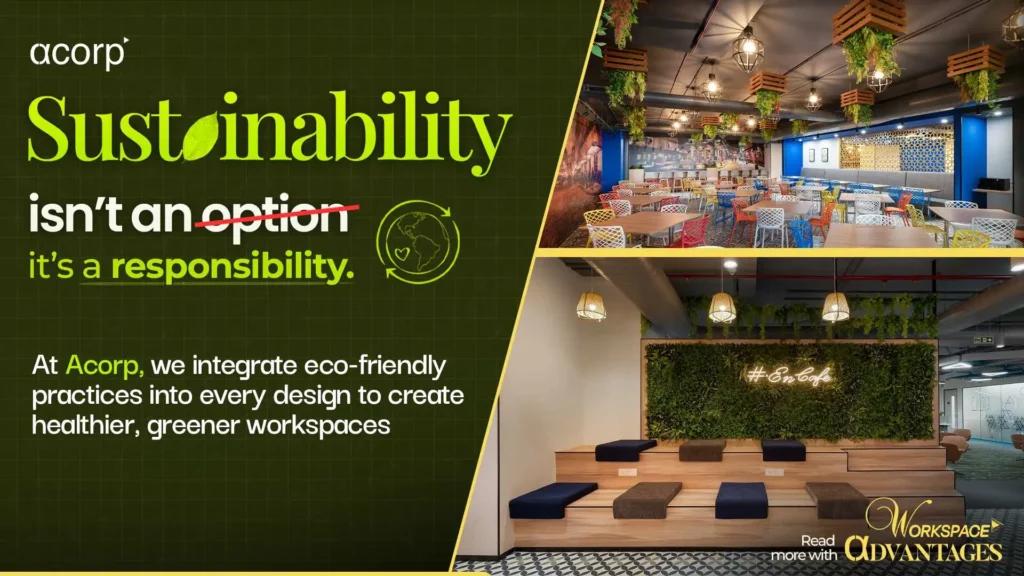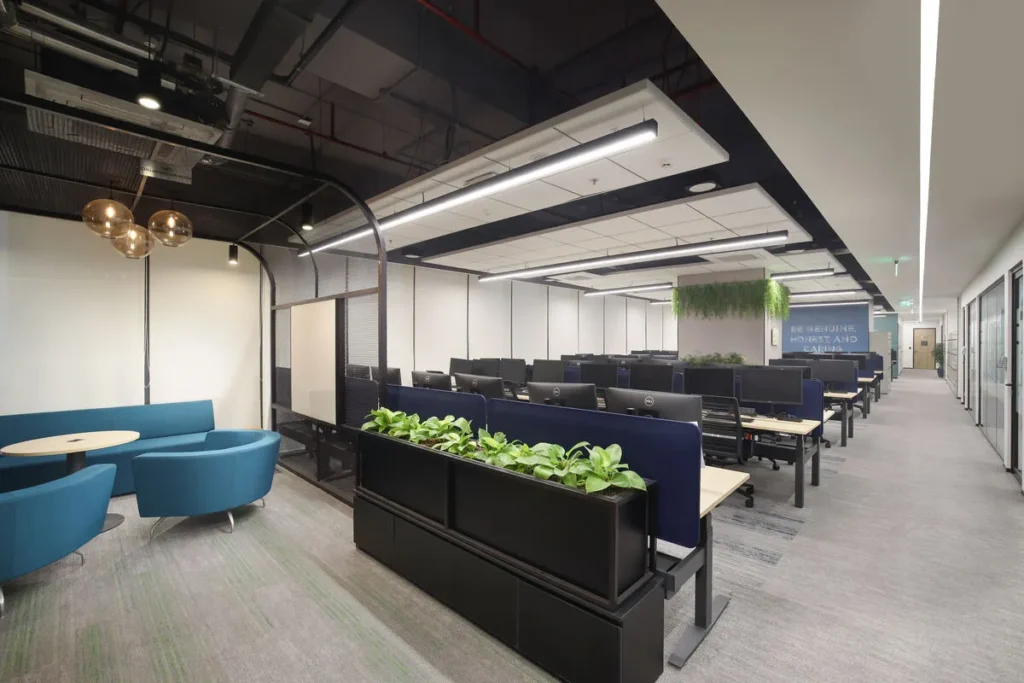
Did you know that commercial buildings consume nearly 40% of the world’s energy and contribute almost 30% of global CO₂ emissions? Yet with thoughtful design and smart operations, any green workspace can shift from an energy drain to a hub of well-being, productivity, sustainability and cost savings.
Why Green Workspaces Matter
- Health & Comfort: Access to daylight, fresh air, and non-toxic materials has been shown to reduce stress, boost mood, and cut sick-day absences by up to 25%.
- Employee Attraction & Retention: A sustainably designed office signals care—for both people and planet—which resonates strongly with today’s talent pool.
- Operational Savings: Simple measures like LED lighting, smart HVAC controls, and low-flow plumbing fixtures can trim energy and water bills by 20–40% in the first year alone, helping to increase productivity while cutting costs
Four Pillars of Eco-Friendly, Sustainable Office Design
- Daylight Harvesting: Use automated shades, light shelves, and occupancy sensors to maximize natural illumination while avoiding glare and overheating.
- Material Selection: Choose upcycled or low-VOC (volatile organic compound) flooring, wall finishes, and furnishings to safeguard indoor air quality.
- Water Efficiency: Implement rainwater harvesting, grey-water reuse, and sensor-activated fixtures to reduce municipal water demand and conserve renewable resources.
- Biophilic Elements: Integrate living walls, potted greenery, or indoor gardens and creating green spaces which is nature’s proven antidote to cognitive fatigue and stress.
Integrating Smart Technologies
- IoT Sensors & Analytics: Real-time monitoring of energy, air quality, and occupancy lets you fine-tune systems and detect inefficiencies before they become costly.
- Adaptive HVAC & Lighting: Machine-learning controls can anticipate usage patterns, pre-cooling or dimming lights only where and when needed.
- Renewables & Storage: Solar panels, battery backups, and microgrids can offset peak charges, reduce CO₂ emissions, and ensure resilience during outages.
Certifications & Standards
Pursuing third-party green building certifications not only benchmarks performance but also elevates your company’s sustainability credentials:
- LEED (Leadership in Energy & Environmental Design)
- WELL Building Standard (focuses on occupant health)
- BREEAM (global life cycle assessment)
Even if full certification isn’t your goal, these frameworks provide clear roadmaps for improvements and get you closer to achieving sustainable development goals.
Real-World Impact
A mid-sized tech firm retrofitted its 20,000 sqft headquarters with daylight sensors, reclaimed-wood workstations, and timed HVAC zones. Within six months, energy costs dropped by 30%, employee satisfaction scores climbed 18%, and the space earned a local green-building award. Their journey began with a simple water-use audit—showing that even small pilots can deliver big results in workplace productivity and employee well-being.
Community & Culture
Sustainable workplaces thrive when employees feel invested in the journey:
- Host “Green Days”, where teams compete to reduce their energy footprint
- Create an on-site “Eco Squad” to pilot new ideas—everything from compost bins to bike-to-work incentives, things that add to environmental sustainability and workplace productivity.
- Share monthly impact reports: celebrating successes builds momentum and accountability.
Future‑Proofing Your Workspace
As work models evolve, design for flexibility and longevity:
- Modular Furniture & Walls: Easily reconfigure teams or repurpose conference rooms without demolition waste.
- Plug-and-Play Infrastructure: Pre-installed power and data drops let you scale up or down with minimal disruption.
- Adaptable Amenities: From nap pods to wellness rooms, give employees spaces that support shifting needs.
Practical Steps You Can Take Now
- Audit Your Usage: Monitor electricity, heating, and water over 3–6 months to identify high-consumption hotspots.
- Set Targets: Aim for at least a 15% reduction in energy or water use within one year.
- Pilot Small Projects: Start with LED upgrades or a single living wall—measure results before scaling up.
- Engage Your Team: Celebrate “Green Days,” invite staff to suggest eco-improvements, and share progress transparently.
Transforming your office into a green workspace doesn’t require a full rebuild—it just takes strategic choices, smart technology, and steady commitment. With a focus on sustainable office design, companies can enhance operations, reduce CO₂ emissions, and align with the sustainable development goals.Share your own success stories or challenges below, and let’s build healthier, more efficient offices—together.
Join the conversation: What’s one simple eco‑upgrade you’d like to tackle next?

